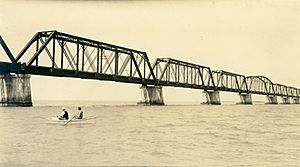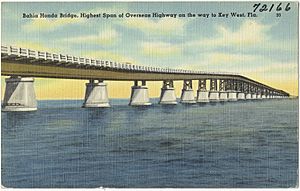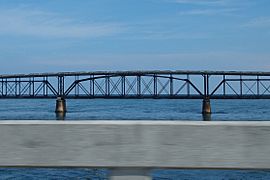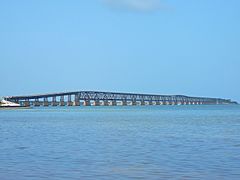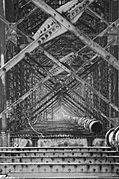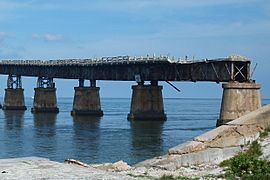Bahia Honda Rail Bridge facts for kids
Quick facts for kids Bahia Honda Rail Bridge |
|
|---|---|
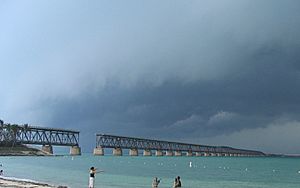
View of the Bahia Honda Bridge from Bahia Honda State Park.
|
|
| Coordinates | 24°39′19″N 81°17′33″W / 24.65520°N 81.29253°W |
| Carries | Single track of Florida East Coast Railway, North and Southbound lanes of U.S. Route 1 |
| Crosses | Bahia Honda Channel |
| Locale | Connects Bahia Honda Key and Spanish Harbor Key |
| Characteristics | |
| Design | Parker (Camelback) Truss Bridge with Pratt Truss and Plate Girder approaches |
| Total length | 5,055 feet (1,541 m) |
| Longest span | 247 feet (75 m) |
| History | |
| Opened | 1912 as rail bridge, converted to highway use in 1938 |
| Closed | 1972 |
The Bahia Honda Rail Bridge is an old, unused railroad bridge in the lower Florida Keys. It connects Bahia Honda Key with Spanish Harbor Key. This bridge was once a key part of the famous Overseas Railway.
After a huge storm in 1935, the state of Florida bought the bridge. They changed it from a train bridge into a road for cars in 1938. This new road became part of the Overseas Highway. Today, a newer bridge carries traffic, and parts of the old Bahia Honda Bridge were removed to keep boats safe and stop people from going onto dangerous sections.
Contents
A Bridge with a Past: How it Started
The Bahia Honda railroad bridge was first built by a man named Henry Flagler. It was part of his big project, the Overseas Railroad. This amazing railway opened in 1912. Flagler used his own money to build the railway all the way from Miami to Key West.
From Train Tracks to Car Lanes
A terrible storm, the Labor Day Hurricane of 1935, badly damaged much of the railway. The company that owned it, the Florida East Coast Railway (FEC), decided they couldn't use it anymore. So, the state of Florida bought the bridge.
In 1938, they changed it for cars to drive on. Instead of building a whole new bridge, workers put a new road surface on top of the old structure. The original train track area inside the bridge was too narrow for cars.
Why Parts Were Removed
A brand new, four-lane bridge was built and opened in 1972. It was placed a little north of the old bridge. This new bridge took over the route for U.S. 1.
After the new bridge opened, two sections of the old bridge were taken out. One section was removed near the east end. This was to let boats pass through the Bahia Honda Channel safely, without old parts falling from the bridge. Another section was removed at the far west end. This was to stop people from walking onto unsafe parts of the old bridge.
Some people think the sections were removed so taller boats could pass. But the new bridge actually has about the same amount of space underneath for boats. The old bridge is now in bad condition. Signs warn boaters to watch out for falling pieces. However, most of the bridge still stands. The section on the east side is still open for people to walk on. It is looked after by Bahia Honda State Park and offers great views for visitors.
How the Bridge Was Built
Before it became a road for cars, the Bahia Honda Rail Bridge carried a single train track. It crossed the Big Spanish Channel, connecting Bahia Honda Key to Spanish Harbor Key. This bridge was special because it was made of steel trusses, which are strong, crisscrossing metal frames.
Strong Design for Deep Water
Most other bridges on the Overseas Railroad were made of concrete arches. But the Bahia Honda Bridge needed a different design. This channel is the deepest one the railway crossed, about 24 feet deep.
The middle part of the bridge uses a special design called a Parker truss. This section is about 247 feet long. On both sides of this central part, there are 13 sections of Pratt trusses, each about 186 feet long. Outside of those, there are 13 more, smaller Pratt trusses, each about 128 feet long.
Nine sections called plate girders were used for the western approach. These are like strong, flat beams. All together, the bridge is about 5,055 feet long. The smaller Pratt trusses were joined with rivets, which are like strong metal pins. But the larger Pratt and Parker trusses used bigger, separate pins to connect their parts. This makes the Bahia Honda Rail Bridge the longest pin-connected truss bridge in the U.S.
William Krome and Joseph Meredith were the main builders of the original bridge. Later, B.M. Duncan oversaw the changes to make it a car bridge.
Gallery
-
Bridge seen from Spanish Harbor Key
See also
 In Spanish: Puente ferroviario de Bahía Honda para niños
In Spanish: Puente ferroviario de Bahía Honda para niños
- Overseas Railroad
- Overseas Highway
- Bahia Honda Key
- History of the Florida East Coast Railway


